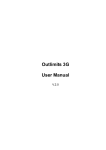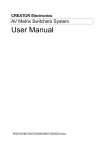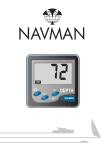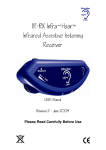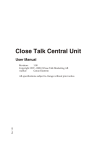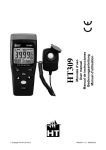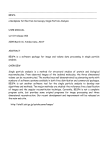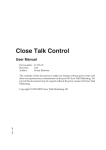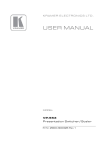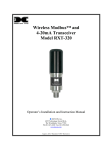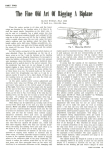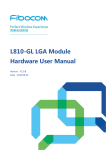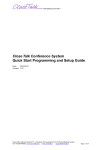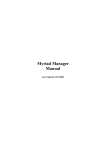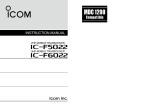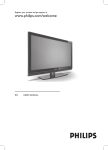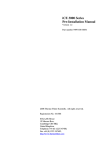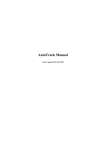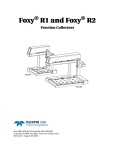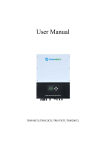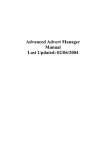Download Product Catalog English 2011 - 5.cdr
Transcript
Wireless Conference System Technology Using Infrared Light In the beginning... The history of Close Talk started in Sweden 1988 with a vision of a completely wireless telephone conference system for board rooms and other high-end installations. The use of radio was quickly discarded and infrared light was chosen as carrier. In 1989 the first delivery of this hand-made, highgrade wooden box microphone system was made. During the coming five years over 500 units where sold on the Scandinavian market to a wide selection of state, municipal and well known local and international companies. In 1997 Close Talk decided it was time to introduce it’s idea to the world. The development of a new generation for the mass-market was started to include products and components designed for ease of use, quick installation, reliability, long life and a reasonable price. At the turn of the millennium the first generation of this new product line saw the light of day. The following two years included a hectic time to build the local Scandinavian market and finally in 2002, generation two was introduced internationally at the annual ProLight&Sound trade show in Frankfurt to intense market interest. In 2005 generation three was introduced world-wide with a host of new features, laying the foundation for the solid conference technology product range available today. Building on a long time of product experience, Close Talk Conference System will continue towards the goal of becoming the worlds most price-worthy wireless conference- and voting system! Project history and market impact Close Talk Conference System has been sold in many thousands of units to numerous prestigious customers such as presidential and governmental offices, United Nations, World Bank, US Senate, numerous municipalities and corporations all over the world. Key features highly appreciated by the customers are ease of installation, ease of use, excellent design, excellent reliability, total safety to eavesdropping and excellent value for money. Company information Close Talk Conference System is owned and run by the Swedish company Apodosis AB that handles product development, marketing and production. The system is fully produced in Sweden, using local subcontractors. Visit us at www.closetalk.se, e-mail us at [email protected] or call us at +46-(0)87645227. © Copyright 2012 - 2015 Close Talk Conference System /Apodosis AB, Sweden All rights reserved. All copying, either in whole or in part, by any means, of this document, for any purposes or use other than to promote Close Talk Conference System, is strictly prohibited! For best results, this document is supposed to be printed dual-sided. Document version: 5 2 Released 2015-March-22 All specifications subject to change without prior notice. The Close Talk Conference System A basic audio-only Close Talk Conference System consists of one or more DU-111-02 Delegate Unit, usually one per conference participant, one CU-110-11 Central Unit which is the system controller, a number of TU-100-xx Transceiver Unit where the required number depends on the required room usage area of the system, a battery charger solution for the delegate units and finally some cables to connect the transceiver units to the central unit. The delegate unit is a battery powered, all-inclusive unit, there are no special models for chairman, voting, etc. The system supports unlimited delegate units with a limit of three active microphones. A central unit acts as the controller of the system with built-in automatic speaker queue and more. Transceivers acts as transmitter/receiver antennas for the IR-signals and are connected to the central unit using RJ-45 Cat. 6 cables. The central unit supports up to eight direct connected transceivers, supporting the most common installation sizes. For larger installations or with complex cabling, an SB-110-01 Split Box is available that acts as a one-to-six port expander. Two battery charger solutions are available for the delegate units, the low-cost DC-110-45 Cord Battery Charger and the CT-10 Trolley Charger that besides battery charging also provides a very convenient transportation and storage functionality. Close Talk Conference System deluxe Close Talk Conference System is a completely modular conference system, the basic audio-only system described above can at any time and at the users convenience be expanded in room size, more delegate units, teleconferencing, recording, camera follow, big screen projection of speaker lists and voting results, voting, speaker and reply list control, attendance management and more, there are no future technology dead-ends waiting around the corner because of system design decisions today. The PC-software Close Talk Control has been, and still is being, developed in close co-operation with municipalities and councils to provide the world markets most powerful conference system solution for formal conference and discussion control. Being wireless, the system provides super flexibility for room re-use. By using infrared light the system investment has a virtually unlimited in time operational guarantee whereas radio based systems are experiencing increasing problems with ether congestion, making Close Talk Conference System a very good long-time investment. Basic components for a conference system: Delegate Unit DU-111-02 Transceiver TU-10002, -03 or -04 or Central Unit CU-110-11 Charger DC-110-45 Trolley Charger CT-10 3 Catalogue Contents r System Introduction - page 5 Describes the system principles, product selection, installation and usage r DU-111-02 Delegate Unit - page 7 Updated - DU-111-02 Delegate Unit is the main microphone and voting unit. There is no special chairman unit in Close Talk Conference System, any unit can be chairman via controller programming r CU-110-11 Central Unit - page 9 Updated - CU-110-11 Central Unit is the main system controller. The built-in microprocessor controls the entire system including an RS-232 port for remote control applications r TU-100-02 Transceiver Unit - page 11 A Transceiver Unit acts as the system antenna. The TU-100-02 Transceiver Unit is for flush mounting using a BOSE ceiling speaker mounting pattern r TU-100-03 Transceiver Unit - page 13 TU-100-03 Transceiver Unit is for flush mounting using spring fastener, suitable for false ceilings r TU-100-04 Transceiver Unit - page 15 TU-100-04 Transceiver Unit is suitable for surface mounting r SB-110-01/2 Split Box - page 17 Updated - SB-110-01/2 Split Box is used to expand the number of supported system transceivers r SU-110-01 Switcher Unit - page 19 New - SU-110-01 Switcher Unit provides automatic switching of adjacently installed systems r Cables - page 21 Installation cables for the Transceiver units r DC-110-45 Cord Battery Charger - page 23 DC-110-45 Cord Battery Charger is a low-cost battery charger for the DU-111-02 Delegate Unit and supports five units per charger r CT-10 Charger Trolley - page 25 CT-10 Charger Trolley is a combined battery charger, transportation and storage trolley for the DU-111-02 Delegate Unit and supports up to twenty four units per trolley r CH-103 Tray Battery Charger - page 27 CH-103 Tray Battery Charger is a fully automatic battery charger for the DU-111-02 Delegate Unit and supports three units per charger. It is normally a part of the CT-10 Charger Trolley but can just as easily be mounted on a wall, in cupboard or a third party trolley r CTPS-101 Battery Charger Power Supply - page 29 CTPS-101 Battery Charger Power Supply is a high-powered power supply for the CT-10 Charger Trolley/CH-103 Tray Battery Charger charger products r Close Talk Control PC software - page 31 Close Talk Control is a Windows compatible PC software that greatly expands Close Talk Conference Systems functionality including voting, camera follow and much more r System Installation Application Note - page 33 Updated - This application note is an instruction for installing the system r Camera Follow Application Note - page 35 Camera follow functionality is implemented via the PC software Close Talk Control as described in this application note r 1 + 1 Language Application Note - page 37 Although expands Close Talk Conference System is primarily a single language system it is possible to do 1 + 1 as described in this application note 4 Introduction to the Close Talk Conference System The Close Talk Conference System is a wireless discussion system based on infrared light transmission which ensures easy installation, superior reliability and security. The basic system components are the Delegate Unit which is the microphone unit used by the conference participants, the Central Unit that controls the system functionality, the Transceiver Unit which is the infrared transmitter and receiver unit and the Split Box which is used as a signal distributor for easy installation. The system has a total of six channels, four audio and two data where the Central Unit receives up to three audio and one data and transmits one audio and one data. Fig. 1: Transceiver Units positioned in the ceiling The transceiver units acts as infrared antennas and are positioned face down on the ceiling. Directly below are the delegate units that receives the outgoing audio and data channel. When a user wants to speak he presses the microphone activation button and if there is a free audio channel, the microphone will be activated in less than a second, if not, the unit is placed in an automatic speaking list. The microphone will remain active until the user releases it by pressing the button again. A maximum of three microphones can be active at the same time. The transceiver- and delegate unit transmits infrared light in a cone-shaped form where the transmission effective surface area increases with height up to a limit at about seven metres (see unit data sheets for actual data). Several transceiver units are used in a grid pattern to provide operation for the required area. Fig. 2: Delegate Units transmits in the opposite direction Several types of transceiver units are available, both for surface and flush mounting. The transceivers are connected to the Central Unit using Cat. 6, S-STP grade RJ-45 cables for easy installation. While the central unit can accept up to eight directly connected transceiver units, a Split Box can be used to expand that number. Another important use for the split box is to reduce the cable lengths in an installation, running a lot of cables from a ceiling down to a technical room, where the central unit is usually placed, is impractical and expensive. The split box is placed as close to the transceiver units as possible, reducing the number of cables needed for the central unit. 5 The central unit is a microprocessor based control unit for the system. It provides the basic conference system functionality such as audio channel management, speaker list and chairman override without operator assistance. In addition it has an extensive set of audio in- and out connections, microphone insert, HF infrastructure connectors and RS-232 serial port. A clean and easy-to-use front panel makes it very simple to access the settings. The unit functionality can easily be upgraded on the field via firmware upgrade. The unit also has an extensive control command set via RS-232 for system testing and remote controlling applications. Close Talk Control is a powerful PC software that via the RS-232 port expands the system dramatically to provide the tools for professional conferencing including voting, speaker lists, advanced database technology and camera follow, all packaged in an easily learned user interface. Central Unit Close Talk Control Transceiver Unit Split Box Delegate Unit The delegate unit has an elegant case design suitable for all environments and is very easy to use, only two buttons to operate. Battery operated with built-in speaker, several microphone alternatives and headphones output. Battery operating time is typically over twenty hours of listen-only, over eight hours of speaking. No special charging arrangements, continuous charging supported without degrading the battery. Battery is of industry standard type and can easily be replaced in the field. Setting up a system is very easy for the end-customer, simply turn the central unit on, place the delegate units in the room, turn them on and start using the system. Chairman priority functionality includes speaking channel guarantee and control in several manners to fit all meeting cultures. Close Talk Conference System is equally suitable as a ten delegate teleconferencing system as a full 100+ large conference room installation. 6 Delegate Unit DU-111-02 The DU-111-02 Delegate Unit is a wireless microphone and voting station with built-in speaker and headphones functionality. Updated - Beginning December 2014 an updated version is shipping with enhanced audio quality. Variable length microphone Power & Speak Buttons IR Transmitter & Receiver The unit uses infrared light as transmission media and has full duplex audio capability. 73 The microphone features include high audio quality, low noise and variable length. Supports four transmitted channels, three audio and one data, and two received channels, one audio and one data. 205 125 Millimeter Powered by an industry standard lead-acid battery ensures fully wireless operation, exceptionally long operating time and superior reliability. Easy battery handling supports continuous charging. Simple operation, only two buttons. No setup required, all settings are controlled remotely. Simply place the unit within range, turn power on and start using. Single audio volume knob with individual operation for speaker- and headphone levels. Universal design, no special chairman unit or voting station versions. Excellent audio characteristics using high quality driver and base reflex box tuning design. Unit firmware can be easily be updated via infrared data link. The use of infrared light ensures full security from eavesdropping. Industry unique variable length microphone suits all users. 7 Technical Data Tender Specification Audio: The Delegate Unit is to comply with all relevant CE regulations. - 200Hz - 7500Hz (-3dB) frequency range - S/N ratio > 80dB - Individual level settings for speaker and headphones - Built-in high quality, polypropylene cone, 2.5” speaker - 3.5mm stereo mini-tele connector for headphones, minimum impedance 8 ohms - Automatic speaker shut-off when inserting headphone Power: -Built-in 6 volt, 3.2Ah lead-acid battery - Industry standard battery type - Battery easily replaced, does not require return to factory - Operating time (fully charged) 20 hours listen-only, 8 hours effective speaking time - Estimated battery life greater than 5 years in normal use - Charging time (fully discharged) 10-14 hours - Fully automatic charging - Continuous charging without battery degradation Transmission: - Fully wireless operation using infrared light - Vertical transmission - 6 channels, four transmitted and two received - Frequency range 2.4 - 5.6MHz - IR wavelength 875nm - Insensitive to visual light including fluorescent - Analog FM modulation - Audio channel S/N ratio 60dB, companded to greater than 80dB - Data channel bit phase modulated, 1.67kb/s Physical: - Size 205x125x73mm (wxdxh) - Weight approx. 1.2kg - Grey plastic case - Microphone length 270-480mm Environment: - Indoor home or office use only - Temperature +10-35 deg. celsius - Battery contains lead, recycle according to local laws and regulations - Recycle case and contents according to local laws and regulations - Clean using soap-water damped cloth only Approvals: - CE and FCC approval - Unit emits safe and harmless infrared light Order code: DU-111-02 8 The unit is to be designed for independent use by a single person and shall be able to transmit and receive audio in full duplex. It shall have a built-in speaker and a 3.5mm stereo mini tele connector for optional headphones use. The volume levels should be independently presettable for speaker- and headphones and the speaker audio should be automatically shut off when a headphone is used. The unit should be fully wireless using harmless, eavesdrop safe, infrared light as transmission media. Infra-red light is to be transmitted vertically relative to operators position. Audio and data is to be transmitted using analog Frequency Modulation and use carrier frequencies in the range 2 to 6MHz and use infrared light with 875nm wavelength. The unit power source shall be a rechargeable, maintenance free battery of industry standard type and be able to be replaced by the end user. The operating time of a fully charged battery shall be minimum 20 hours of listen only and 8 hours of effective speaking time. The re-charging time of a fully discharged battery shall be no longer than 14 hours. A low battery indication shall be included using an LED lamp indicator. The unit should power down automatically 2 minutes after the loss of the main audio carrier. Unit type shall be of universal use including built-in voting and chairman functionality. Unit functionality should be easily upgradeable via wireless firmware updates. Operation of the unit shall consist of a clearly organised, two button operator panel with 4 LED lamps showing power status, microphone activity and voting result selection. A volume knob should be easily accessible for speaker and headphones level setting. The microphone shall contain an LED lamp for activity indication. The activation time of the microphone should be less than 1 second using a single button press. In the situation of no available speaking channels, the unit should clearly indicate that it has been placed in a speaker queue using an LED lamp status indicator. The unit shall be able to switch between audio and voting mode without operator assistance. The state of voting shall be clearly visible using the status LED lamps. Casting a vote should be done using a single or double button operation. Delegate Unit model Close Talk, type DU-111-02 or equivalent. Central Unit CU-110-11 The CU-110-11 Central Unit is a controller unit for Close Talk Conference System. Updated - Beginning December 2014 an updated version is shipping with enhanced audio quality. 281 Millimeter Acting as the system hub it controls all aspects of the system using microprocessor technology. LCD Display Supports an unlimited number of Delegate Units, all units within infrared signal range are operational. 44 Control knobs Power switch 480 Up to three simultaneously active microphones. Intelligent functionality includes automatic speaker list, chairman priority, audio level control, remote controlling and more. All functions are easily reached using the 16x2 character, LED backlit, LC display together with a two button and one rotary knob control panel. Balanced (XLR) and unbalanced (1/4” Tele) Line & Tele HF signal connectors RS-232 Insert Power input Fuse Unit settings can be PIN code protected. Supports up to eight High Frequency signal connections including the TU-100-02, TU-100-03 and TU-100-03 Transceiver Units directly connected to the CU-110-11. Supports four received channels, three audio and one data, and two transmitted channels, one audio and one data. Powered by a safety grounded 12VDC switch mode power supply provides superior reliability and safety. World-power input range ensures easy installation. Sturdy 1U steel case for 19” rack mounting. RS-232 serial port for remote control applications such as Close Talk Control PC software for conference control and Close Talk Install PC software for system testing. All connections are easily accessible on the rear panel. Rear panel contains 8 HF signal connectors, RS-232 serial port, system fuse, microphone signal insert, power input, four balanced XLR Line- and Tele in and outputs, four unbalanced 1/4” Tele Line- and Tele in and outputs. The number of Transceiver Units can be expanded above eight using the Split Box SB110-01 or equivalent. Low power consumption. Unit firmware can be easily be updated via the RS-232 serial port. 9 Technical Data Tender Specification Audio: The Central Unit is to comply with all relevant CE regulations. - 200Hz - 7500Hz (-3dB) frequency range - S/N ratio > 80dB - Equalizer for Delegate Unit microphone signal - Insert connector for Delegate Unit microphone signal - Balanced and unbalanced Line- and Tele audio connectors Power: - 12VDC operation - World-power range 100-240VAC input power supply - Power consumption 11W (no transceivers connected) - Power supply supports up to eight directly connected Transceiver Units (type dependent) - Front panel system power switch The configuration of the unit shall be facilitated by an easily readable LC display and status lamps . The display shall be backlit. An easy-to-use two-button and rotary switch panel provides access to the unit. The unit configuration shall be able to protect using a PIN code. With proper installation configuration, the unit shall be able to provide intended functionality without end-user assistance. The unit shall provide the connection of up to eight High Frequency infrared transmission units. Transmission: - 6 channels, four received and two transmitted - Frequency range 2.4 - 5.6MHz - Analog FM modulation - Audio channel S/N ratio 60dB, companded to greater than 80dB - Data channel bit phase modulated, 1.67kb/s Physical: - Size 480x281x44mm (wxdxh) - Weight approx. 4.5kg - Black steel case - 1U 19” rack mounting Environment: - Indoor home or office use only - Temperature +10-35 deg. celsius - Recycle case and contents according to local laws and regulations - Clean using soap-water damped cloth only Approvals: - CE and FCC approval The wireless transmission of audio shall be in full duplex, using analog FM modulation with carrier frequencies in the 2 to 6MHz range. Line-level audio in- and outputs shall be provided for the transmission of audio to external equipment and the reception of audio from external equipment. Balanced audio in- and outputs are to be facilitated using industry standard XLR connectors. Unbalanced audio in- and outputs are to be facilitated using industry standard 1/4” Tele connectors. An Insert connector shall be provided for external audio processing of the delegate microphone signal. The unit is to be powered by a safe, low level, direct current voltage using an external power converter with worldpower input range (100-240VAC). System power shall be operated using a single switch on the unit front panel. Unit functionality should be easily field upgradeable via firmware updates. The unit shall provide an activation time of microphones to be less than 1 second (Delegate Unit dependent), support up to three simultaneously active microphones, provide an automatic first-in-first-out speaker list in the situation of no available speaking channels, and provide chairman override functionality. By means of a built-in RS-232 serial port, the system shall be able to be remote controlled in all major aspects of the system functionality. Audio feedback reduction functionality shall be built-in. The unit case shall be of steel, black color and suitable for standard 19” rack mounting. Central Unit model Close Talk, type CU-110-11 or equivalent. Order code: CU-110-11 10 Transceiver Unit TU-100-02 Transmitter The TU-100-02 Transceiver Unit is an infrared light Receiver transmitter and receiver unit. Designed for ceiling flush mounting it acts like an infrared antenna, receiving the signals sent from the Delegate Units and transmitting the signals to the Delegate Units. 112 Twenty-four transmitter LED´s are used for two outgoing channels, one audio and one data. Eight photodetectors converts the received IR signals into an electric signal that is sent to the controller. 112 Millimeter TU-100-02 is connected to the system using an industry standard CAT. 6, S-STP grade cable with quickconnect RJ-45 connectors. Front diameter 180mm RJ-45 connector EMC shield The unit is self-powered via the cable and can accept cable segments of up to 30 metres. Low power consumption and weight makes safe and easy ceiling positioning easy. Several Transceiver Units can be placed in a grid pattern on the ceiling to cover all common room types. S-STP grade cable -5 -4 -3 -2 -1 0 Emits safe and harmless infrared light with an 875nm wavelength. 1 2 3 4 5 meter 1 2 Standard front plate colour is white, other colours available on special order. Mounting is by four screws, standard BOSEä ceiling speaker pattern. 3 4 5 6 7 Designed for the 2-6MHz signal range makes it insensitive to visible and fluorescent light. Connects directly to the Central Unit or via a Split Box. 8 9 10 Operating range is equipment dependent. The figure above shows a radiation diagram together with the DU-111-02 Delegate Unit where the horizontal axis shows radiation diameter at ceiling heights up to seven metres. 11 Technical Data Tender Specification Power: The Transceiver Unit is to comply with all relevant CE regulations. - 10.3 - 13VDC operation - Power consumption 3.6W at 12VDC - Powered through cable The unit is intended for vertical transmission and reception of infrared light with an 875nm wavelength. Emission power shall be of harmless nature. Transmission: - Broadband receiver and two channel transmitter - Receiver frequency range 2.4 - 5.6MHz - infrared light wavelength 875nm - Operating range is equipment dependent, see diagram on other side - Minimum distance to reflective object including a Delegate Unit is two metres vertically The unit shall transmit two channels and have a broadband receiver for analog, FM modulated signals in the 2 - 6MHz carrier frequency range. The unit shall be connected to the system using industry standard CAT. 6, S-STP grade network cables. Operating power shall be provided via the cable at up 30 metre segment lengths. Physical: - EMC shield box size 92x92x8mm (wxdxh), front plate diameter 180mm - Weight approx. 0.32kg - White steel front plate - Flush mounted, four screws fastener, (wall mounting not supported) - To avoid excessive safety ground currents to enter the system, do not connect case to or mount on a grounded surface Operating power voltage levels and power consumption shall provide for safe mounting without special cooling arrangements. The unit shall be flush mounted face-down in a standard BOSEä 112x112mm ceiling speaker pattern using four screws for fastening. The unit is to be of round front plate design. Front plate material is to be steel and be of white colour. At request, other colours can be provided. Environment: - Indoor home or office use only - Temperature +10-35 deg. celsius - Recycle case and contents according to local laws and regulations - Clean using soap-water damped cloth only. Avoid moisture to enter the unit. Approvals: - CE and FCC approval Order code: TU-100-02 12 Transceiver Unit model Close Talk, type TU-100-02 or equivalent. Transceiver Unit TU-100-03 The TU-100-03 Transceiver Unit is an infrared light transmitter and receiver unit. Front diameter 150mm Spring fastener Designed for flush mounting on a ceiling, it acts like an infrared antenna, receiving the signals sent from the Delegate Units and transmitting the signals to the Delegate Units. Receiver 98 Twenty-four transmitter LED´s are used for two outgoing channels, one audio and one data. Eight photodetectors converts the received IR signals into an electric signal that is sent to the controller. TU-100-03 is connected to the system using an industry standard CAT. 6, S-STP grade cable with quick-connect RJ-45 connectors. 98 The unit is self-powered via the cable and can accept cable segments of up to 30 metres using a standard AWG26 cable. 60 Cable inlet Transmitter Millimeter Low power consumption and weight makes safe and easy ceiling positioning easy. Several Transceiver Units can be placed in a grid pattern on the ceiling to cover all common room types. -5 -4 -3 -2 -1 0 1 2 3 4 5 meter 1 2 Emits safe and harmless infrared light with an 875nm wavelength. 3 Standard front plate colour is white, other colours available at request. 5 4 6 7 Mounting is by two springs, ideal for false ceiling use, cut a square hole, connect the cable and slip it in. 8 9 10 Designed for the 2-6MHz signal range makes it insensitive to visible and fluorescent light. Connects directly to the Central Unit or via a Split Box. Operating range is equipment dependent. The figure above shows a radiation diagram together with the DU-111-02 Delegate Unit where the horizontal axis shows radiation diameter at ceiling heights up to seven metres. 13 Technical Data Tender Specification Power: The Transceiver Unit is to comply with all relevant CE regulations. - 10.3 - 13VDC operation - Power consumption 3.6W at 12VDC - Powered through cable The unit is intended for vertical transmission and reception of infrared light with an 875nm wavelength. Emission power shall be of harmless nature. Transmission: - Broadband receiver and two channel transmitter - Receiver frequency range 2.4 - 5.6MHz - infrared light wavelength 875nm - Operating range is equipment dependent, see diagram on other side - Minimum distance to reflective object including a Delegate Unit is two metres vertically The unit shall transmit two channels and have a broadband receiver for analog, FM modulated signals in the 2 - 6MHz carrier frequency range. The unit shall be connected to the system using industry standard CAT. 6, S-STP grade network cables. Operating power shall be provided via the cable at up 30 metre segment lengths. Physical: - EMC shield box size 98x98x60mm (wxdxh), front plate diameter 150mm - Weight approx. 0.55kg - White steel front plate - Flush mounted, two spring fastener (wall mounting not supported) - To avoid excessive safety ground currents to enter the system, do not connect case to or mount on a grounded surface Environment: - Indoor home or office use only - Temperature +10-35 deg. celsius - Recycle case and contents according to local laws and regulations - Clean using soap-water damped cloth only. Avoid moisture to enter the unit. Approvals: - CE and FCC approval Order code: TU-100-03 14 Operating power voltage levels and power consumption shall provide for safe mounting without special cooling arrangements. The unit shall be flush mounted face-down on a ceiling using two springs for fastening. The unit is to be of round front plate design. Front plate material is to be steel and be of white colour. At request, other colours can be provided. Transceiver Unit model Close Talk, type TU-100-03 or equivalent. Transceiver Unit TU-100-04 The TU-100-04 Transceiver Unit is an infrared light transmitter and receiver unit. Millimeter 98 Designed for ceiling surface mounting it acts like an infrared antenna, receiving the signals sent from the Delegate Units and transmitting the signals to the Delegate Units. 23 Twenty-four transmitter LED´s are used for two outgoing channels, one audio and one data. Eight photodetectors converts the received IR signals into an electric signal that is sent to the controller. Receiver TU-100-04 is connected to the system using an industry standard CAT. 6, S-STP grade cable with quick-connect RJ-45 connectors. RJ-45 connector Cable inlet 98 Transmitter EMC shield The unit is self-powered via the cable and can accept cable segments of up to 30 metres using a standard AWG26 cable. Low power consumption and weight makes safe and easy ceiling positioning easy. Several Transceiver Units can be placed in a grid pattern on the ceiling to cover all common room types. Emits safe and harmless infrared light with an 875nm wavelength. S-STP grade cable -5 -4 -3 -2 -1 0 1 2 3 4 5 meter 1 2 3 Standard case colour is white, other colours available on request. 4 Mounting is by two screws through the back cover. Unit is self-fastened to the back cover using a screw-less snap-on grip. Opening is easily done with mid size flat nose screw driver. 6 Designed for the 2-6MHz signal range makes it insensitive to visible and fluorescent light. 10 Connects directly to the Central Unit or via a Split Box. 5 7 8 9 Operating range is equipment dependent. The figure above shows a radiation diagram together with the DU-111-02 Delegate Unit where the horizontal axis shows radiation diameter at ceiling heights up to seven metres. 15 Technical Data Tender Specification Power: The Transceiver Unit is to comply with all relevant CE regulations. - 10.3 - 13VDC operation - Power consumption 3.6W at 12VDC - Powered through cable The unit is intended for vertical transmission and reception of infrared light with an 875nm wavelength. IR emission power shall be of harmless nature. Transmission: - Broadband receiver and two channel transmitter - Receiver frequency range 2.4 - 5.6MHz - infrared light wavelength 875nm - Operating range is equipment dependent, see diagram on other side - Minimum distance to reflective object including a Delegate Unit is two metres vertically The unit shall transmit two channels and have a broadband receiver for analog, FM modulated signals in the 2 - 6MHz carrier frequency range. The unit shall be connected to the system using industry standard CAT. 6, S-STP grade network cables. Operating power shall be provided via the cable at up 30 metre segment lengths. Physical: - Size 98x98x23mm (wxdxh) - Weight approx. 0.33kg - White steel case - Ceiling surface mounted, two screws (wall mounting not supported) - To avoid excessive safety ground currents to enter the system, do not connect case to or mount on a grounded surface The unit shall be mounted face-down on a ceiling surface using two screw for fastening. Operating power voltage levels and power consumption shall provide for safe mounting without special cooling arrangements. The unit is to be of square case design. Case material is to be steel and be of white colour. At request, other colours can be provided. Environment: - Indoor home or office use only - Temperature +10-35 deg. celsius - Recycle case and contents according to local laws and regulations - Clean using soap-water damped cloth only. Avoid moisture to enter the unit. Approvals: - CE and FCC approval Order code: TU-100-04 16 Transceiver Unit model Close Talk, type TU-100-04 or equivalent. Split Box SB-110-01 The SB-110-01 Split Box is a one input, six outputs High Frequency signal distributor for the Close Talk Conference System. The primary function is to expand the number of supported Transceiver Units, the distributor input is typically connected to the controller output, multiplying the possible number of Transceiver Units by six, and the outputs are connected to the Transceiver Units. Another important use is to reduce the total cable lengths needed for an installation. The Split Box is recommended to be placed as close to the Transceiver Units as possible, minimizing their cable segment lengths and making it possible to have only one longer cable running to the controller. The unit is powered by a double-isolation, ungrounded 12VDC switch mode power supply that provides superior reliability and safety. World-power input range ensures easy installation. Power switching is done automatically using a status signal from the controller, when the controller shuts down, all Split Boxes and Transceiver Units are switched off. Millimeter 28 185 110 Six HF signal outputs Screw holes for mounting HF signal input with S-STP grade cable Status lamps Power supply input Split Boxes may be daisy-chained in a tree fashion for even greater support of Transceiver Units or to reduce total cable lengths even more. Sturdy steel case with four screw fastening. Low power consumption produces less heat for easy and safe mounting. Connectors are quick-connect RJ-45 for fast and trouble-free installation. Status lamps shows power input and on/off state. New! The Split Box now supports having Transceivers directly connected to the Central Unit, in parallel with the Split Box, add 5 meter cable length per Split Box for directly connected transceivers. 17 Technical Data Tender Specification Power: The Split Box is to comply with all relevant CE regulations. - 11-13VDC operation, 12VDC nominal - World-power range 100-240VAC input power supply - Power consumption 6W (no transceivers connected) - Power supply supports up to six directly connected Transceiver Units (type dependent) - Automatic power switching using signal from controller The unit shall have one High Frequency signal input and automatically distribute all system signalling to six individual outputs without configuration or user assistance. Capabilities: - One input port, six output ports distributor - Input can be connected to controller or daisy-chained with other Split Boxes - Outputs can be connected directly to Transceiver Units or daisy-chained with other Split Boxes The six outputs shall be able to handle one infrared transceiver unit or be able to connect to another Split Box for expansion purposes. The unit is to be powered by a safe, low level, direct current voltage using an external power converter with worldpower input range (100-240VAC). Unit power shall be controlled automatically by the system controller. Physical: - Size 185x110x28mm (wxdxh) - Weight approx. 0.7kg - White steel case - Four screw fastening - To avoid excessive safety ground loop currents, do not connect case to or mount on a grounded surface. Do not use a safety grounded power supply Environment: - Indoor home or office use only - Temperature +10-35 deg. celsius - Recycle case and contents according to local laws and regulations - Clean using soap-water damped cloth only Approvals: - CE and FCC approval Order code: SB-110-01/2 18 The unit self heating shall be low enough for safe mounting without special cooling arrangements. The unit case shall be of steel, white colour and have a four screw mounting method. Split Box model Close Talk, type SB-110-01 or equivalent. Switcher Unit SU-110-01 The SU-110-01 Switcher Unit is designed for automatic switching between two physically adjacent systems, e.g. a room with a removable divider wall, where the systems need to be used as two individual systems in separate rooms and as one system in both rooms with very little setup time. Two Central Units are required which are connected to the SU-110-01 Central Unit One input and SU110-01 Central Unit Two input respectively. The transceiver section of the area to be controlled by Central Unit One is connected to the SU-110-01 System One output and the second area is connected to the SU-110-01 System Two output. Although it is possible to connect a Transceiver Unit directly to the Switcher Unit outputs, it is strongly recommended to use a Split Box to connect the transceivers. With both Central Units turned on the two systems works independently. Turning off either Central Unit connects the transceivers from both areas to the remaining active Central Unit. Any of the two Central Units can be shut down making special applications possible using different Central Unit setups. The SU-110-01 Switcher Unit is self-powered by the Central Units via the signal cables. The Switcher Unit is also parallel capable, i.e. Transceivers can be connected directly to the Central Unit, in parallel with the Switcher Unit node, if the cabling is planned correctly. Similar to the Split Box the Switcher Unit ”adds” or is equivalent to 5 meters of cable which means that cables for directly connected equipment, in parallel with the Swicther Unit should be 5 meters longer totally. Switcher Unit SU-110-01 System Two 1 Split Box Two 2 e tiv Ac t2 u utp ut e Inp 2 O tiv Ac 1 2 ut t tpu 1 Inp 1 Ou Max 30 meters Max 50 meters System One Central Unit One Central Unit Two Split Box One 19 Technical Data Tender Specification Power: The Switcher Unit is to comply with all relevant CE and FCC regulations. - 11-13VDC operation, 12VDC nominal. Powered by the Central Units, no external power supply needed - Power consumption 3W (no outputs connected), 3.8W (one output connected) and 4.3W (both outputs connected) - Automatic power switching using signal from Central Unit The unit should be self-powered by the system controller units. Switching between system should be automatic and not require any manual operation at the unit. Capabilities: Switcher Unit model Close Talk, type SU-110-01 or equivalent. - Two input and two output ports - Controls two systems with automatic port switcthing - Acts as a signal amplifier, extending the maximum cable length capabilities - Outputs can be connected directly to a singe Transceiver Unit but the use of Split Boxes is strongly recommended Physical: - Size 185x110x28mm (wxdxh) - Weight approx. 0.7kg - White steel case - Four screw fastening - To avoid excessive safety ground loop currents, do not connect case to or mount on a grounded surface Environment: - Indoor home or office use only - Temperature 0-40 deg. celsius - Recycle case and contents according to local laws and regulations - Clean using soap-water damped cloth only Approvals: - CE and FCC approval Systems are color-coded by LED green for System 1 and yellow for system 2 The system that is active on the output is indicated by the LED:s on the Output ports, green or yellow 28 1 2 e tiv Ac t2 tpu ut Inp e 2 Ou v cti Millimeter A 1 2 ut ut tp Ou 1 Inp 1 185 110 Input and Output for system 1 and 2 Screw holes for mounting Order code: SU-110-01 20 Installation cables Close Talk Conference System is designed for and all it's certifications are based on the use of the industry standard Cat. 6 S/FTP grade Ethernet cable type. The S/FTP (formerly known as S-STP) grade means double shielding, i.e. all four signal pairs have an individual shield and then the four pairs have a common outer shield. There are several other Ethernet cable types and categories on the market, namely U/UTP (UTP) Unshielded Twisted Pair, F/UTP (FTP) Foil Shielded Twisted Pair and U/FTP (STP) Shielded Twisted Pair. Although the system will work with other cable types than S/FTP (S-STP), it will not operate according to specifications, it's safety against eavesdropping is severely reduced and the warranty is void. Power under-voltage states may occur, resulting in system instability. Close Talk Conference System supplies ready-made cables in lengths of 5, 10, 15, 25, 30 and 50 meters which enables quick and problem-free installation, please see next page for ordering information. It is also possible to use custom built cables but please note: - Always use Cat. 6 S/FTP (S-STP) cables - Use shielded connectors - When using RJ-45 Cable Joiners/Extenders, use a shielded type - Use the industry standard straight RJ-45 Ethernet patch cable pin-out - Follow the installation rules found in the full product catalog Important! Close Talk Conference System uses proprietary signaling, not Ethernet. Only connect Close Talk equipment to a Close Talk system or property damage may occur! 21 Close Talk Conference System provides six standard cable lengths: - 5 meter length - 10 meter length - 15 meter length - 20 meter length - 30 meter length - 50 meter length 22 - order code 08-101-05 order code 08-101-10 order code 08-101-15 order code 08-101-20 order code 08-101-30 order code 08-101-50 Delegate Unit Battery Charger DC-110-45 DC-110-45 is a cost effective battery charger for the DU-111-02 Delegate Unit. It supports five units per charger and has fully automatic charging functionality, simply plug the charger to the delegate unit charger connector. The DC-110-45 is designed with the “standby” charging method for Lead-Acid battery types. This means very long battery life at the expense of charging times which increases slightly, a full charge is about 14 hours. Using the “standby” charging method means that the charger can be connected to the delegate units continuously, there is no maximum charging time. Delegate Unit Charger Connector It is recommended to have the charger connected whenever the system is not used, providing an ever-ready conference system. The LED charging indicator is an easy way to check charging status, a fully lit LED indicates charging where the brightness slowly decreases to dimmed, indicating done. The power supply is uses world-power voltage range and is ungrounded for easy use in large systems. The DC-110-45 battery charger is a very cost effective and easy to use solution, for a more powerful charging and transportation solution, the CT-10 Charger Trolley is available, please see separate data sheet. 23 Technical Data Tender Specification Physical: Size (Box WxHxD) Size (Power Supply WxHxD) Total Weight Cable length PS->Charger Box Cable lengths Charger Box->DU The battery charger should be designed for Lead-Acid battery type. Electrical: Voltage Frequency Power Mains plug Indication Charging: Method Charging time Indication 80x55x25mm 95x45x30mm 0,4kg 170cm 45cm 100-240VAC Automatic range selection 50/60Hz Max. 30W Ungrounded (double isolation) Green LED for power on Fully automatic, “standby” Lead-Acid charging Max 14 hours Five red LED indicators Charging method should be according to the “standby” method to maximize battery life. The battery charging cycle shall be fully automatic and not require any operator assistance other than initial cable connections. Power and charging status should be indicated via easily read LED lamps. Charger should support a minimum of five target units per charger. Battery charger power supply should be of ungrounded, double isolation type, have world-power range input of at least 100 - 240VAC and support both 50 and 60Hz power frequency. Battery charger Close Talk, type DC-110-45 or equivalent. Please specify mains plug type when ordering! EU, USA, UK and CHINA/AUSTRALIA generally available. Order code: DC-110-45 24 Delegate Unit Charger and Transportation Trolley CT-10 CT-10 is a combined battery charger and transportation trolley for the DU-111-02 Delegate Unit and can hold up to 24 units. The sturdy frame and wheels provides safe transportation and storage. Using the CT-10, any conference system size can be setup and removed in minutes. The trolley size makes it easy to roll around in the conference room using a suitable wheel size to provide easy passing over thresholds. Wheel locks are provided for safe storage. 750mm/29.5” 1210mm/47.6” The Delegate Unit holders have built-in battery chargers with automatic connection, no need for a manual charger cable connector insertion. Easy operation, simply place the Delegate Unit´s in their holders, roll the trolley to the storage room and plug it in to mains power. Charging is controlled automatically. Each holder has an individual charging status indicator clearly showing the OFF, CHARGING and READY states. Charging time is typically 10 hours for a fully discharged battery (see holder data sheet). 510mm/24” Units can safely be left in the charger during storage, making them ever ready for the longest of meetings. 25 CT 10 can be equipped to suit any installation. The trolley supports up to eight CH-103 Charger Holders and one CTPS-101 Power Supply which are ordered individually. Each charging holder is connected to the power supply at the bottom of the frame using a simple, low voltage, two wire cable. Power supply is connected using a regular power cord for easy operation, simply plug in to mains power and turn on to start charging. Easy to assemble and can be upgraded later with more charger holders. Compact design saves storage space. Data Size: Width Depth Height Weight: Frame Holder Supply 750mm/29.5” 510mm/24” 1210mm/47.6” 12.9kg/28lbs 2.5kg/6lbs 2,2kg/4.8lbs Frame, eight holders and a power supply is about 35kg/77lbs. Twenty four Delegate Units adds 29kg/64lbs resulting in a maximum weight of 64kg/141lbs. Order code: CT-10 This order code is for the trolley frame only, add one CTPS-101 and one to eight CH-103 per trolley! 26 Electrical: Voltage 100-120VAC 200-240VAC Frequency 50/60Hz Power Max. 150W Delegate Unit Battery Charger CH-103 24mm/0.94” 720mm/28.4” 142mm/5.6” CH-103 is a fully automatic battery charger for the DU-111-02 Delegate Unit. With a three unit capacity and active charging control, keeping the Close Talk Conference System ready for action is now easier than ever. The CH-103 removes the need to manually connect each unit to a charger using a connector, simply place the delegate unit in it’s holder and charging starts automatically. Charging is actively controlled to minimize charging time while preserving maximum battery life and is designed for stand-by use, supporting continuous charging. Three unit capacity Charging status indicators shows the OFF, CHARGING and DONE states. When charging is ready, simply lift the unit out of it’s holder and start using. CH-103 is powered by the CTPS-101 power supply using simple, quick-connect cable terminals. Although primarily designed for use with the CT-10 Charger Trolley, the unit can just as easily be mounted on a shelve, a wall, etc. using the supplied brackets. Mounting bracket kit Power and charging status indicators 27 710mm/27.95” Mounting holes for 8mm screws Power input connectors Bracket mounting Technical Data Physical: Size (WxHxD) Weight Colour Electrical: Supply voltage Supply current Charging current Charging voltage 720x24x142mm 28.4x0.94x5.6” 2,5kg/5.5lbs Black 9±0,2VDC Max.1,25ADC Max. 0,38±0,02ADC 6,8±0,1VDC Power input connection Tender Specification The battery charger should be designed for Lead-Acid battery type. Charging method should be according to the “standby” method to maximize battery life. The battery charging cycle shall be fully automatic and not require any operator assistance other than initial unit seating. Power and charging status should be indicated via easily read LED lamps. Charger shall be a combination unit that, besides battery charging, can be used as a storage and transportation solution. Battery charger power supply should be safe low voltage DC operation. Tray battery charger Close Talk, type CH-103 or equivalent. Order code: CH-103 This order code is the tray charger only, add a CTPS-101 as power supply. Each power supply supports up to eight CH-103. 28 Delegate Unit Battery Charger Power Supply CTPS-101 60mm/2.4” 176mm/7” 300mm/11.8” CTPS-101 is a high capacity power supply designed to provide power to the CH-103 Charger Holder unit. At 100W output power it can supply up to eight CH-103 directly. Using a sturdy steel box, it is intended for quick and safe mounting on the CT-10 trolley frame but can just as easily be used stand-alone in applications where the trolley is not needed. Completely silent operation using fanless box self ventilation. Easy installation with screw-less low voltage connectors for up to eight units. Easy operation, plug in and turn on, no settings required. 29 Data Physical: Size (WxHxD) 300x60x176mm 11.8x2.4x7” Weight 2,2kg/4.8lbs Cable gland for low voltage power output Electrical: Input: Voltage Mains power input connector, switch and fuse holder 100-120VAC or 200-240VAC Internal range selection switch Frequency 50/60Hz Power Max. 150W Fuse 2AT @ 110VAC 1AT @ 230VAC Output: Voltage 9±0,2VDC Current Max. 11ADC INSTALLATION GUIDELINES Warning! Installation should only be carried out by a qualified technician, improper installation may result in property damage and/or personal injury. Only mount unit with free ventilation airways, leave at least 25mm/1” free air space around unit surfaces. Select the correct mains voltage range and input fuses. Do not overload the power supply. Maintain correct low voltage output polarity. Always unplug from mains when opening cover. See the CT-10 Installation Manual for more detailed information about installation including mounting and connecting the CH-103 charger holders. Ventilation inlet, outlet on top cover. Mains voltage range selector Low voltage output fuse Low voltage output connector terminals Mains voltage filter Order code: CTPS-101 30 Mounting holes for 5mm screws Conference Control Software Close Talk Control Close Talk Control is a Microsoft Windows 2000/XP/Vista/7 compatible PC software that enhances the Close Talk Conference System with expanded conference control, voting, attendance and fee management. Conference management includes fully controllable Speaker and Reply lists. Audio channel usage is easily visible and managed. Speaker list size and control fully configurable. No limit to the number of Delegate Units supported. System audio settings are easily accessible. Fully configurable, position and size of all control panels are saved. Vital parts of the software such as audio settings can be password protected. Delegate unit contact and battery test function for easy preconference security. Includes and extends all Central Unit functionality. Adds powerful database functionality including delegate and seating lists. Speaking time can be limited automatically on individual basis using the delegate list. Separate program window displays speaker lists and voting results, suitable for video projection. Powerful roll call functionality includes traditional roll call and “Free Arrival” mode. Basic functionality easily learned for inexperienced computer user’s. Included is a basic Agenda manager where the meeting can be structured. Current matter is included in all reports. Attendance and Fee management is a function used for creating attendance reports for conference delegates. During a conference, tools in the Seating List is used to update the arrival and departure of delegate. Each event is noted in the time log. After a conference, detailed attendance reports can be produced for each seat. The attendance data can also be used to produce fee reports for all participating delegates. 31 With a simple mouse click the delegate units become voting stations. Simple vote result selection using single delegate unit button. Vote result displays include table, time counter, bar graph, summary and seating view. Seating View result display is fully configurable geoplacement display using the built-in editor. Delegate’s have individual vote weight including fractions for share holder meetings. Voting period can be timed or operator controlled. Vote results can be printed and/or exported as RTF document for archiving purposes. Close Talk Control gets even more powerful by the addition of camera follow functionality. Using the VISCA camera bus control developed by SONYä, any VISCA capable camera can be used. Supporting up to seven cameras, where each can be programmed for a variety of conference events, complex video supported conferencing scenarios can be implemented. Intelligent camera selection logic makes the best use of available cameras. Tender Specification The Software is to provide advanced conference control functionality including voting. The Software shall be designed to execute on a Personal Computer running any of the Microsoftä Windows 2000, XP, Vista or 7 operating systems. Database functionality shall be implemented for easy configuration of multiple conferencing scenarios. The database functionality shall include a comprehensive person database and seating arrangements. Attendance and fee management shall be implemented. The database functionality makes it easy to store and retrieve multiple conference configurations. Person databases, seating arrangements, attendance and fee functionality and voting functionality shall all provide detailed mid and post-conference report capabilities, both in physically printed form and as exported electronic documentation. Close Talk Control is very resource efficient and will run on any modern Personal Computer. One RS-232 serial port is required, one optional for camera control. A second computer display output is recommended Audio system settings and usage, system operation status, speaker lists shall be easily verified and controlled. The Software is to support multiple graphic display outputs for video projection and broadcasting purposes. Camera follow functionality is to be provided with multi-camera and multi-zone programming support. Vote result display should include bar-graph, summary and geo-placement display modes. Software Close Talk Close Talk Control or equivalent. Close Talk Control has three base functions, Conference Management, Voting and Attendance and Fee Management. Conference Management is always included, resulting in four available software packages: Order Number Includes CTC-OPT-1 Conference Management CTC-OPT-2 Conference Management + Voting CTC-OPT-3 Conference Management + Attendance and Fee Management CTC-OPT-4 Conference Management + Voting + Attendance and Fee Management 32 System Installation Step 1: Determine the actual operating area, i.e. the area where the Delegate Units are used. Step 2: Determine the ceiling height at the operating area and use a diagram similar to figure 2 to get the range diameter. -5 -4 -3 -2 -1 0 1 2 3 4 Room size 15x10 metres Actual operating area size 11x6 metres 5 metre 1 2 Fig.1: It is rarely necessary to have complete wall-to-wall coverage, determine the actual operating area and its location 3 4 5 6 Step 3: Use the coverage area diameter and layout all the necessary transceivers and their positions to cover the operating area. 7 8 9 10 Fig.2: Use the ceiling height to find the IR signal coverage for a single transceiver, for example, at 3.5 metres ceiling height, the diameter is 6 metres. 6 x 0.9 is 5.4 metres. It is normally enough to connect the area borders when placing the transceivers, the area in between will be “filled” by the co-operation of the transceivers. In our example we have an overlap vertically but only since two transceivers would not be enough. Fig.3: Use the resulting coverage diameter and fill the operating area with the necessary number of transceivers. In our example, with a ceiling height of 3.5 metres, a single line of transceivers will not completely cover the area so a dual row adds plenty of safety margin. Step 4: We now have the positions for the transceivers. Determine where the Central Unit and , if used, the Split Boxes will be placed. Ground rule one: Each transceiver must have the same cable length with in a one metre margin between the Transceiver and the Central Unit. When using Split Boxes, simply ignore the box and add the length of cable for the Transceiver and the length of the cable between the Split Box and Central Unit. When using more than one Split Box in the same room, it is only the total length of the cable that matter, i.e. if the cables between Split Box 1 and the Transceivers is 5 metres and the cable between Split Box 1 and the Central Unit is 10 metres, a total cable length of 15 metres, the total length for Split Box 2 must be the same but can be a different configuration, for example 10 + 5 metres. Fig.4: The Transceivers (red) are connected to the Split Box (yellow) using 10 metre cables. The cable slack for the two upper Transceivers have been rolled together. The Split Box is then connected to the Central Unit (blue) using another 10 metre cable. Ground rule two: A cable connected to a Transce iver cannot be longer than 30 metres. Ground rule three: The cable between a Split Box and the Central Unit cannot be longer than 50 metres. 33 Ground rule four: Do not place Transceivers vertically closer to another object, including a Delegate Unit, than 1 metres. Too much IR light intensity will overload the system. Ground rule five: Transceivers should optimally be mounted face down on the ceiling. Mounting the transceivers angled is possible but requires some testing. Horizontal transmission on wall mounting is not recommended. It is strongly recommended to use Close Talk Conference System cables, they are ready-made cables in lengths of 5, 10, 15, 20, 30 and 50 meters which enables quick and problem-free installation. Close Talk Conference System is designed for and all its certifications are based on the use of the ISO/IEC 11801 industry standard Cat. 6 S/FTP grade Ethernet cable type. The S/FTP (formerly known as S-STP) grade means double shielding, i.e. all four signal pairs have an individual shield and then the four pairs have a common outer shield. Do not use UTP, FTP or STP grade cables, it may cause system stability problems and will void system warranty. It is also possible to use custom built cables but please note: •Always use Cat. 6 S/FTP (S-STP) cables •Use shielded connectors •Always test the cable before connecting it to any Close Talk products, a faulty cable may cause product damage not covered by warranty •When using RJ-45 Cable Joiners/Extenders, use a shielded type •Use the industry standard straight RJ-45 Ethernet patch cable pin-out •Faulty custom-built cables, either from using the wrong components or by poor manufacturing, may seriously compromise the system stability and its protection against eavesdropping •Roll up cable slack using bow ribbon shape, not a coil •Minimum cable bending radius is 30mm, lower than that may damage the cable and cause system instability Important! Close Talk Conference System uses proprietary signaling, not Ethernet. Only connect Close Talk equipment to a Close Talk system or property damage may occur! After connecting the components, the system is ready for power on. When turning on the system, pay attention to the power lights on the Central Unit and Split Boxes, they should all be brightly lit. Use the analyser software Close Talk Install, freely downloadable from www.closetalk.se, to test the IR signal coverage. When the IR signals are considered OK the system can then be tuned using the Central Unit settings as described in the supplied Central Unit User Manual. It can also be downloaded from www.closetalk.se. Important: This document is a quick introduction to the system installation principles. Always consult the full product documentation such as product manuals and web site before making an actual installation. 34 Camera Follow - An introduction Camera follow is implemented in the Close Talk Conference System via the PC software Close Talk Control. With its powerful database functionality it provides easy configuration of the system for a variety of applications. The camera follow functionality is based on the VISCA camera control bus protocol from SONYä, enabling any VISCA capable camera to be used. Up to seven cameras can be controlled for maximum flexibility where each can be programmed for specific events during the conference. To start using camera follow with the Close Talk Conference System, all that is needed is a regular PC with two free RS-232 serial ports, the Close Talk Control software and one or more cameras. The Central Unit is connected to the first serial port on the PC using a null-modem cable. The cameras are connected to the second RS-232 port using an industry standard VISCA to PC serial cable. With more than one camera, the cameras are daisy-chained using a standard VISCA cable (see the camera documentation). VISCA to PC cable between PC and first camera VISCA daisy-chain cable between cameras Null-modem cable between PC serial port and controller serial port The following description assumes familiarity with the Close Talk Control software functionality, the user manual will provide more information. Added to the Close Talk Control softwares Seating Table is a Position column. Position is simply a list of programmed camera positions connected to one or more Seat Numbers. Any Position number can be used one or more times for any Seat Number making it possible to program detailed close-ups for each delegate or only a few section shots of the entire conference room. Fig. 1: Seating Table To program the camera control system, start the Camera configuration function on the software main menu. The configuration panel contains two selection trees, communication port settings and camera type settings. Begin by selecting the correct serial port number. VISCA has preset serial port settings so only the port number is important, the other parameters have no effect. 35 Selecting the “VISCA - Generic” branch will show the VISCA programming and control panel. After selecting the correct serial port number, connect the cameras to the port and turn them on. Wait until the cameras have settled and click the Update button in the Bus control group (see figure 4). The number of connected cameras should be shown within a second at Cameras . If not, verify port settings, cables and cameras and try again. Fig. 2: Camera configuration panel Fig. 3: Serial port selection The Position entries in the Seating Table must be matched to actually programmed positions here. Click the New button to start adding positions. Besides delegate positions, Voting and Neutral can be added where Voting is a position for vote mode and Neutral is the resting positions for the camera. Use Erase to remove a position, use the 1x and 5x to navigate the position list. The 1 to 7 G and P buttons are Goto and Program buttons for up to seven cameras. Click the P button to program the position for the corresponding camera number. The camera state is stored in the position number/type shown at Position. Click G to send the corresponding camera to the programmed position. Click Shift-P to delete a specific cameras position. The PSpeed and TSpeed settings are the Pan Speed and Tilt Speed for the cameras. Different camera types accepts different speeds, if the camera misbehaves after changing these two settings, reduce it until the camera responds or verify the setting with the camera specifications. Camera selects the current camera to be controlled. Click Lft, Rgt, Up, Dwn to pan and tilt in single steps, use Shift-Click to move in multiples of 10, Control-Click to move in steps of 100 and Shift-Control-Click to move in steps of 1000. The In and Out buttons control zoom, use Shift-Click to move in larger steps. Be patient with the movement controls, let the camera move in its own pace, following the progress on a video monitor. Several methods of camera handling are available including Exclusive camera, Most recent microphone and Maximize usage. To configure Close Talk Control to use camera control, click the Select button and close the Camera configuration panel. When starting the conference, the selected system type will be initialized. To disable camera follow, click the Disable button (figure 3). Fig. 4: VISCA programming panel 36 1 + 1 Language application Although Close Talk Conference System is a single channel conference system it is still possible to use for dual-language applications. By breaking the signal path for the incoming delegate unit microphone audio and instead sending it via the controller Line Out to an external PA the conference system outgoing audio is freed for an additional language. The PA audio is also routed to the interpreter booth headphone amplifier which means the interpreter will only hear what is spoken into the delegate unit microphones. The amplified interpreter microphone signal is connected to the controller Line In port. The delegate unit speaker audio is turned off and the headphones signal is set to a comfortable range where the delegates can set their own level using the delegate unit volume knob. Each delegate unit is equipped with a headphone where the delegates listen to their own language using the PA and use the headphones for the second language. Conference room PA, Delegate Unit microphone audio Interpreter booth headphone- and microphone amplifier From Controller Line Out To Controller Line In Conference system From Controller HF out 37 These are the required settings for the Central Unit, consult the Central Unit User Manual for a detailed description of each parameter. Parameter EQ Low Setting X Comment Does not affect the delegate unit microphone signal going to the PA, no effect EQ High X Does not affect the delegate unit microphone signal going to the PA, no effect Delegate Volume Off Removes the incoming delegate microphone audio from the outgoing audio to the delegate units Line In 36 Recommended setting is for Line Level signals, adjust as needed Line Out 36 Recommended setting provides Line Level signals, adjust as needed Micro. Compens. 2:x 3:y If no external feedback destroyer is available, adjust as needed. With external feedback destroyer, set to 2: 0 3:0 Speaker Volume 0 0 Turns the delegate unit speaker off Headphones Vol. 16 26 Sets the delegate unit headphones output level span, adjust to the actual headphones used Other Central Unit parameters are not directly related to the 1 + 1 language configuration, consult the user manual and set as required for the desired system operation. 38






































